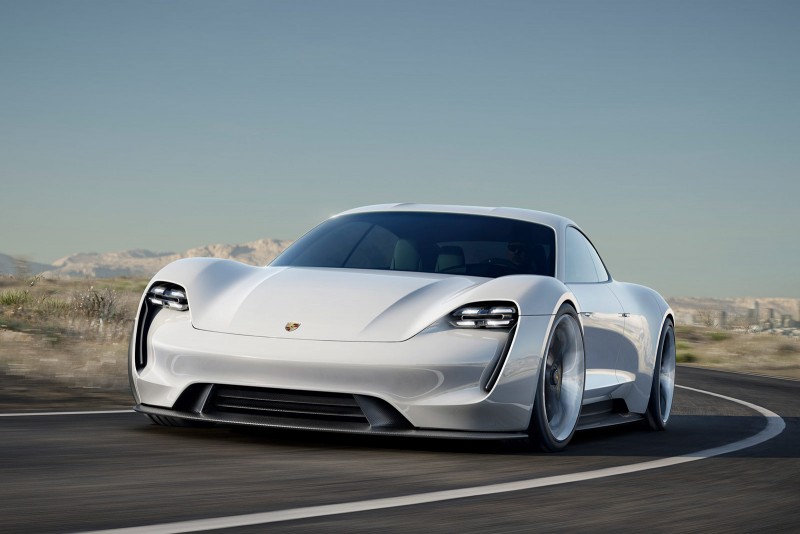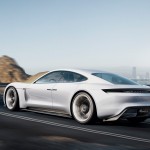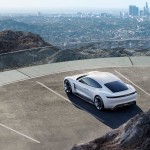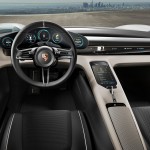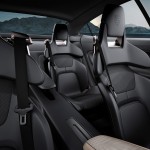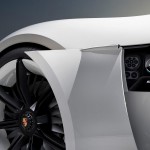Mission E is Porsche’s first foray into the world of electric vehicles and it is one that certainly doesn’t disappoint.
Introduced at the Frankfurt International Auto Show (IAA) 2015, the car’s key points include a driving range of 300 miles, a hearty 600 hp and a rapid charge time of just 15 minutes to 80% range.
A standout feature of the car is its 800 Volt drive system, that sports Two permanent magnet synchronous motors (PMSM), similar to those used in Porsche’s 919 Hybrid LMP1 race car. These provide 600 hp and near instant torque.
Being a Porsche, it of course has to exhibit an exciting driving character and the Mission E is no exception. 0-62 mph takes, “less than 3.5 seconds,” and 124 mph is reached in, “less than 20 seconds.” The all-wheel drive system uses torque vectoring to automatically provide power to the wheels that need it most. No Porsche is worth its salt of course, until it has proven itself on the Nürburgring Nordschleife and the Mission E can complete a lap there in under eight minutes.
Being an electric car, charging is of the utmost importance and the Mission E is capable of being charged in several different ways. Rapid charging can be done using an 800 Volt port called Porsche Turbo Charging System. Alternatively, the system can use a more conventional 400 Volt system or even wireless inductive charging. The battery uses the latest lithium-ion chemistry too and is housed at the lowest centre of gravity to provide better handling.
Aside from its obvious sports car credentials, the Mission E also features a high level of practicality. Seating is provided for four persons and being a concept car, Porsche have taken the opportunity to install some very clever interior highlights. These include a virtual OLED instrument cluster display with an eye-tracking system that detects which instrument the driver is viewing. The idea is that the driver can then activate the specific menu on that instrument with a simple button press on the steering wheel. Glances can then be used to navigate the menu, along with button presses to confirm choices.
But that is not all: the display follows the seat position and body attitude of the driver in what is known as a parallax effect. If the driver sits lower, higher or leans to one side, the 3D display of the round instruments reacts and moves with the driver. This eliminates situations in which the steering wheel blocks the driver’s view of certain key information, for instance. All relevant information such as vehicle speed is always within the driver’s line of sight.
In typical concept car style, the Mission E can also detect the mood of the driver and comically displays it as an emoticon. Apparently, Porsche haven’t yet discovered the mirror.
The dashboard is an area where Porsche have particularly gone to town with new ideas. There is a holographic display that extends from driver side to passenger side and can show selectable apps including touch-free controls like media, navigation, climate and phone/social contacts. Touch has made way for gesture control, so you can expect passengers to appear more like they’re Tom Cruise in Minority Report than actually controlling a car. Similar in principle also to Microsoft’s XBOX Kinect sensor controls, a grasping motion means ‘select’ which pulling means control.
Mission E is a connected car too, and can be controlled using Porsche Car Connect on a compatible tablet/smart phone. Similar to Tesla’s over the air (OTA) updates, Mission E is equally capable of receiving updates wirelessly. Remote diagnostics and much more can also be controlled using Porsche Connect.
The keen eyed amongst you might have noticed Mission E doesn’t sport any external rear view mirrors. This is because they are aerodynamically unfriendly and have been replaced with cameras, that have accompanying displays in the interior and can show much more than a conventional mirror. Porsche are in good stead to make this a reality, since parent company Volkswagen’s XL1 featured a similar idea.
